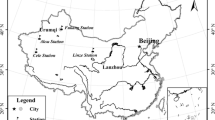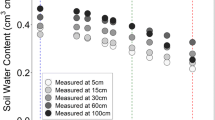Abstract
The consumptive use of water by irrigated crops is typically quantified using the crop coefficient–reference evapotranspiration (Kc–ETo) procedure; yet, recent results showed that Kc might change with ETo, in response to high atmospheric demand. It is not known if the reduced Kc at high ETo applies to other crops with different aerodynamic features of the canopies. This paper seeks to provide the Kc values for soybean, wheat and potato, and propose an adaptation to the Kc–ETo procedure, hypothesising that the inverse relation between Kc and ETo would be general for all types of crops. Our results showed average Kc values of 0.90, 1.18 and 1.28, respectively, for soybean, wheat and potato cropping systems in the Brazilian cropping systems. However, Kc decreased as ETo increased, for all crops considered in this study, because of the increase of internal plant resistances to vapour diffusion from the leaves to the atmosphere. When ETo was above > 4 mm d−1, the water use by such crops was lower than that prescribed by Allen et al. (JAMA, 1998). The time-based Kc curves in Allen et al. (JAMA, 1998) are inappropriate for the studied crops under high demanding conditions and, besides the considerations suggested by Allen et al. (JAMA, 1998) (i.e., crop development stage, presence or absence of weeds), Kc recommendations for practical irrigation management should be based on the average ETo values of the previous days of the irrigation procedure.




Similar content being viewed by others
References
Allen RG (2000) Using the FAO-56 dual crop coefficient method over an irrigated region as part of an evapotranspiration intercomparison study. J Hydrol 229(1–2):27–41. https://doi.org/10.1016/S0022-1694(99)00194-8
Allen RG, Pereira LS (2009) Estimating crop coefficients from fraction of ground cover and height. Irrig Sci 28:17–34. https://doi.org/10.1007/s00271-009-0182-z
Allen RG, Jensen ME, Wright JL, Burman RD (1989) Operational estimates of reference evapotranspiration. Agron J 81(4):650–662. https://doi.org/10.2134/agronj1989.00021962008100040019x
Allen RG. Pereira LS, Raes D, Smith M (1998) Crop evapotranspiration: guidelines for computing crop water requirements. FAO Irrigation and Drainage Paper No. 56. FAO, Rome, Italy
Allen RG, Pruitt WO, Wright JL, Howell TA, Ventura F, Snyder R, Itenfisu D, Steduto P, Berengena J, Yrisarry JB, Smith M, Pereira LS, Raes D, Perrier A, Alves I, Walter I, Elliott R (2006) A recommendation on standardized surface resistance for hourly calculation of reference ETo by the FAO56 Penman–Monteith method. Agric Water Manage 81(1–2):1–22. https://doi.org/10.1016/j.agwat.2005.03.007
Allen RG, Pereira LS, Howell TA, Jensen ME (2011) Evapotranspiration information reporting: I. Factors governing measurement accuracy. Agric Water Manag 98:899–920. https://doi.org/10.1016/j.agwat.2010.12.015
Angelocci LR, Marin FR, de Oliveira RF, Righi EZ (2004) Transpiration, leaf diffusive conductance, and atmospheric water demand relationship in an irrigated acid lime orchard. Braz J Plant Physiol 16:53–64. https://doi.org/10.1590/S1677-04202004000100008
Barros RS, Maestri M, Rena AB (1995) Coffee crop ecology. Trop Ecol 36:1–19
Buttery BR, Tan CS, Buzzell RI, Gaynor JD, MacTavish DC (1993) Stomatal numbers of soybean and response to water stress. Plant Soil 149:283–288. https://doi.org/10.1007/BF00016619
Choudhury B (1983) Simulating the effects of weather variables and soil water potential on a corn canopy temperature. Agric Meteorol 29:169–182. https://doi.org/10.1016/0002-1571(83)90064-X
Cohen S, Cohen Y (1983) Field studies of leaf conductance to environmental variables in citrus. J Appl Ecol 20:561–570. https://doi.org/10.2307/2403526
Denmead OT, Shaw RH (1962) Availability of soil water to plants as affected by soil moisture content and meteorological conditions. Agron J 54:385–390. https://doi.org/10.2134/agronj1962.00021962005400050005x
Döll P (2002) Impact of climate change and variability on irrigation requirements: a global perspective. Clim Chang 54(3):269–293. https://doi.org/10.1023/A:1016124032231
Doorenbos J, Pruitt WO (1977) Crop water requirements. FAO Irrigation and Drainage Paper No. 24 (rev.). FAO, Rome, Italy
Fanjul L, Arreola-Rodriguez R, Mendez-Castrejon MP (1985) Stomatal responses to environmental variables in shade and sun grown coffee plants in Mexico. Exp Agric 21:249–258. https://doi.org/10.1017/S0014479700012606
Franke AE, Konig O (1994) Determinação do coeficiente de cultura (K c) da batata (Solanum tuberosum L.), nas condições edafoclimáticas de Santa Maria, RS. Pesq Agropec Bras 29(4):625–630
Gao Y, Yang L, Shen X, Li X, Sun J, Duan A, Wu L (2014) Winter wheat with subsurface drip irrigation (SDI): crop coefficients, water-use estimates, and effects of SDI on grain yield and water use efficiency. Agric Water Manag 146:1–10. https://doi.org/10.1016/j.agwat.2014.07.010
Jagtap SS, Jones JW (1989) Stability of crop coefficients under different climate and irrigation management practices. Irrig Sci 10(3):231–244. https://doi.org/10.1007/BF00257955
Kjaersgaard JH, Plauborg F, Mollerup M, Petersen CT, Hansen S (2008) Crop coefficients for winter wheat in a sub-humid climate regime. Agric Water Manag 95:918–924. https://doi.org/10.1016/j.agwat.2008.03.004
Köppen W (1931) Grundriss der klimakunde [Outline of climate science]. Walter de Gruyter, Berlin
Liu F, Jensen CR, Shahanzari A, Andersen MN, Jacobsen SE (2005) ABA regulated stomatal control and photosynthetic water use efficiency of potato (Solanum tuberosum L.) during progressive soil drying. Plant Sci 168:831–836. https://doi.org/10.1016/j.plantsci.2004.10.016
Marin FR, Angelocci LR (2011) Irrigation requirements and transpiration coupling to the atmosphere of a citrus orchard in Southern Brazil. Agric Water Manag 98:1091–1096. https://doi.org/10.1016/j.agwat.2011.02.002
Marin FR, Angelocci LR, Righi EZ, Sentelhas PC (2005) Evapotranspiration and irrigation requirements of a coffee plantation in southern Brazil. Exp Agric 41(2):187–197. https://doi.org/10.1017/S0014479704002480
Marin FR, Jones JW, Singels A, Royce F, Assad ED, Pellegrino GQ, Justino F (2013) Climate change impacts on sugarcane attainable yield in southern Brazil. Clim Chang 117:227–239. https://doi.org/10.1007/s10584-012-0561-y
Marin FR, Angelocci LR, Nassif DSP, Costa LG, Vianna MS, Carvalho KS (2016) Crop coefficient changes with reference evapotranspiration for highly canopy-atmosphere coupled crops. Agric Water Manag 163:139–145. https://doi.org/10.1016/j.agwat.2015.09.010
McNaughton KG, Jarvis PG (1983) Predicting effects of vegetation changes on transpiration and evaporation. In: Koszlowski TT (ed) Water deficits and plant growth, vol 7. Academic Press, New York, pp 1–47
Nassif DSP, Marin FR, Costa LG (2014) Evapotranspiration and transpiration coupling to the atmosphere of sugarcane in southern Brazil: scaling up from leaf to field. Sugar Tech 16:250–254. https://doi.org/10.1007/s12355-013-0267-0
Neukam D, Böttcher U, Kage H (2016) Modelling wheat stomatal resistance in hourly time steps from micrometeorological variables and soil water status. J Agron Crop Sci 202:174–191. https://doi.org/10.1111/jac.12133
Oosterhuis DM, Walker S (1987) Stomatal resistance measurement as an indicator of water deficit stress in wheat and soybeans. South African J Plant Soil 4:113–120. https://doi.org/10.1080/02571862.1987.10634956
Payero JO, Irmak S (2013) Daily energy fluxes, evapotranspiration and crop coefficient of soybean. Agric Water Manag 129:31–43. https://doi.org/10.1016/j.agwat.2013.06.018
Perez PJ, Castellvi F, Ibañez M, Rosell JI (1999) Assessment of reliability of Bowen ratio method for partitioning fluxes. Agric For Meteorol 97(3):141–150. https://doi.org/10.1016/S0168-1923(99)00080-5
Roberts J, Nayamuth RA, Batchelor CH, Soopramanien GC (1990) Plant-water relations of sugar-cane (Saccharum officinarum L.) under a range of irrigated treatments. Agric Water Manag 17(1–3):95–115. https://doi.org/10.1016/0378-3774(90)90058-7
Sionit N, Kramer PJ (1976) Water potential and stomatal resistance of sunflower and soybean subjected to water stress during various growth stages. Plant Physiol 58:537–540. https://doi.org/10.1104/pp.58.4.537
Sobenko LR, Souza TT, Gonçalves AO, Bianchini VJM, Silva EHFM, Souza LT, Marin FR (2018) Irrigation requirements are lower than those usually prescribed for a maize crop in southern Brazil. Exp Agric 2018:1–10. https://doi.org/10.1017/S0014479718000339
Suyker AE, Verma SB (2009) Evapotranspiration of irrigated and rainfed maize–soybean cropping systems. Agric For Meteorol 149(3–4):443–452. https://doi.org/10.1016/j.agrformet.2008.09.010
Syvertsen JP, Lloyd JJ (1994) Citrus. In: Schaffer B, Andersen PC (eds) Handbook of environmental physiology of fruit crops: sub-tropical and tropical crops, vol 2. CRC Press, Boca Raton, pp 65–99
Tardieu F, Zhang J, Gowing DJG (1993) Stomatal control by both [ABA] in the xylem sap and leaf water status: a test of a model for draughted or ABA-fed field-grown maize. Plant Cell Environ 16:413–420. https://doi.org/10.1111/j.1365-3040.1993.tb00887.x
Teare ID, Kanemasu ET (1972) Stomatal-diffusion resistance and water potential of soybean and sorghum leaves. New Phytol 71:805–810. https://doi.org/10.1111/j.1469-8137.1972.tb01959.x
Thom AS, Stewart JB, Oliver HR, Gash JHC (1975) Comparison of aerodynamic and energy budget estimates of fluxes over a pine forest. Quart J Royal Meteorol Soc 101(427):93–105. https://doi.org/10.1002/qj.49710142708
Turner NC (1968) Stomatal resistance to transpiration in three contrasting canopies. Crop Sci 9(3):303–307. https://doi.org/10.2135/cropsci1969.0011183X000900030015x
Voz J, Oyarzún PJ (1987) Photosynthesis and stomatal conductance of potato leaves—effects of leaf age, irradiance, and leaf water potential. Photosynth Res 11:253–264. https://doi.org/10.1007/BF00055065
Acknowledgements
The authors are grateful to Dr. Leandro G Costa for the work in part of the sugarcane experiment.
Funding
This study was funded by the Brazilian Research Council (CNPq, grant nos. 301424/2015-2 and 401662/2016-0) and the Research Foundation of the State of São Paulo (FAPESP, grant nos. 2000/12237-5, 2011/18072-2, 2014/12406-4, 2014/05887-6, 2017/20925-0, 2017/50445-0 and 2017/25894-5).
Author information
Authors and Affiliations
Corresponding author
Ethics declarations
Conflict of interest
The authors declare that they have no conflict of interest.
Additional information
Publisher’s note
Springer Nature remains neutral with regard to jurisdictional claims in published maps and institutional affiliations.
Rights and permissions
About this article
Cite this article
Marin, F.R., Angelocci, L.R., Nassif, D.S.P. et al. Revisiting the crop coefficient–reference evapotranspiration procedure for improving irrigation management. Theor Appl Climatol 138, 1785–1793 (2019). https://doi.org/10.1007/s00704-019-02940-7
Received:
Accepted:
Published:
Issue Date:
DOI: https://doi.org/10.1007/s00704-019-02940-7




